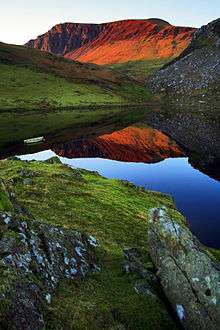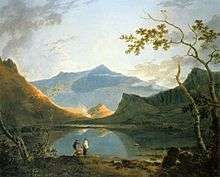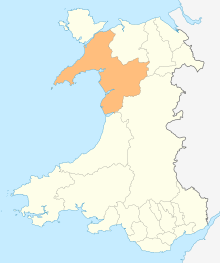Nantlle Valley
The Nantlle Valley (Welsh: Dyffryn Nantlle, IPA: [ˈdəfrɨn ˈnantɬɛ]) is an area in Gwynedd, north Wales, characterised by its numerous small settlements.

The area is also historically important geologically, and featured in one of the most contentious disputes of the 19th century, between the 'Diluvialists' who believed in the Biblical flood, and the ‘Glacialists’, who supported the Glacial Theory, which was substantially established by studies of the drift sediments on Moel Tryfan.[1]
Between 85-90% of the population of the Nantlle Valley speak Welsh as their first language.[2]
Some of the communities came into being as a result of slate quarrying in the late eighteenth or early nineteenth centuries and some have a history stretching back to antiquity. There are Iron Age forts at Caer Engan[3] in Pen-y-groes and on the coast at Dinas Dinlle[4] and evidence of Bronze Age settlement on the higher ground.[5] The valley was important during the Middle Ages - with a clas or ecclesiastical college developed at Clynnog Fawr.
The Glynllifon estate can trace its foundation historically to the 8th century and there is evidence of occupation on the site going back to the Iron Age.
There were a number of quarries in the valley, the largest being the Dorothea and Pen yr Orsedd quarries. Although the major quarries are worked out, there remains demand for slate waste for garden decoration.
In 1991, Antur Nantlle Cyf was established as a community enterprise to work for the benefit of the Nantlle Valley and its surrounding area.
Slate quarrying
Dyffryn Nantlle was one of the major slate quarrying regions of Wales during the nineteenth and twentieth centuries, having at least 37 operating slate quarries at one given time. It was an innovative region in the development of the slate industry. The Cilgwyn quarry on the north side of the valley is the oldest in Wales and one of the oldest in Europe, dating from the 12th century.
The first steam engine to be used in the slate industry was a pump installed at the Hafodlas quarry in the valley in 1807. Slate roofing tiles have been excavated at Segontium Roman camp in Caernarfon and are thought to have originated in the Nantlle Valley. The quarries of the area are being considered as a World Heritage site.[6]
Unlike most of the other slate producing regions in Wales the Nantlle Valley developed a large number of small, independent quarries because most of the land in the valley was owned by a number of small landowners rather than a single large landowner. At the height of the industry there were over 50 quarries being worked in the valley.
Due to this the quarries were never managed as a large single concern as they were in the Penrhyn, Dinorwic and the Festiniog area quarries and this led to the industry in the area being much more vulnerable to any downturns in the economy. This also led to the development of an industrial landscape that is quite different from the other slate quarrying regions in that there are a large number of small waste slate heaps around the valley.
There were considerable difficulties involved in raising slate from the pits and in keeping them free from water, and the ingenious ways which were found to solve these problems, including blondins, chain inclines and vast revetments, are some of the principal reasons why the slate quarrying remains in this area, many of which are unique, are so important. Some of the principal features include the 1906 Cornish beam-engine at Dorothea, a unique survival in Wales, the mill and a number of pyramids, also unique, and the blondins at Pen-yr-Orsedd quarry.
Originally there were two lakes on the valley floor but one has now disappeared and the water is largely contained by the Dorothea quarry pit.

A dispute between local crofter-quarrymen and the local large landowner, Lord Newborough of the Wynn family from Glynllifon became an important legal landmark in the early 19th century. In 1823, Lord Newborough tried to have a law passed to give him control of all the Moel Tryfan Commons, including recent encroachments, and to extinguish the rights of common use. This move was met with fearsome opposition, not least from one John Evans who was concerned that enclosure around the Cilgwyn quarries would affect his own interests, particularly over a dam and watercourse that he had constructed on Crown land in 1816.
Evans organised a commoners’ petition against the Bill, with seven hundred signatures. The petitioners claimed that their cottages had been built over forty years earlier, that originally the land had been too wild for cultivation, and that they had improved it by hard work. This led to a change in the land enclosure law in the United Kingdom.
Another dispute much celebrated in the area took place a generation later centred on the largest quarry in the valley. Dorothea Quarry was bought in 1835 by an Englishman called Muskett. He spent heavily on new equipment to raise the wagons from the quarry bottom. But he overspent, and was declared bankrupt a few years later. The quarry was closed with three months wages owing to most of the workers. They consequently revolted and demolished the new house Muskett had built for himself - Plas y Cilgwyn.
The Nantlle Railway
.jpg)
The horse-drawn 3 ft 6 in (1,067 mm) gauge Nantlle Railway served the quarries from 1828 to 1963, although from 1865 the line was cut back to Tyddyn Bengam, and in 1871 only the portion from the standard gauge railhead at Nantlle railway station in Talysarn was in use. The Nantlle railway has a long history as an industrial and passenger line.
The line received its Act of Parliament in 1825 and was constructed under the supervision of Robert Stephenson, brother of George Stephenson. It opened in 1828 and was operated using horse power. Although built mainly for the transport of slate, the line is known to have carried passengers at various times between Caernarfon and Pen-y-groes.
It is the last recorded use of horses by British Railways, and closed only with the closure of the branch line to which it connected after the Beeching Review in 1963.[7]
Culture
The Nantlle Valley is famous within Wales for being the main setting of the Fourth branch of the Mabinogion, Math fab Manawydan, the story of Lleu Llaw Gyffes, Blodeuwedd and Gwydion. The story is set mainly in the area with Gwydion finding Lleu transfigured into an eagle in an oak tree at Baladeulyn (the ground that used to exist between the two lakes before industrialisation). There are numerous references to the valley in the Welsh Triads (Trioedd Ynys Prydain) as well.
The valley was noted for its woodlands and was an important area in the Middle Ages, being used as a hunting park for the royal family of Gwynedd. After the Edwardian conquest in 1282, one of the first recorded jousts in Britain was held on the fields of Baladeulyn near the village of Nantlle as the royal entourage made its way from Nefyn after the war. Rules were apparently drawn up here which later were the basis of the 1292 Statute of Arms issued by Edward I to regulate jousting.
The area is also famous for the variety, breadth and amount of folk-lore associated with fairies, right up until the present times. This lore was recorded extensively by John Owen Huws in the 1970s and 1980s and published in his landmark three-volume work Straeon Gwerin Ardal Eryri (Gwasg Carreg Gwalch, 2008).
The Nantlle Valley also became one of the power-houses of Welsh literature during the 20th century. Notable examples include the poetsT.H. Parry-Williams from Rhyd Ddu and R. Williams Parry from Talysarn. Mathonwy Hughes, from Mynydd Cymffyrch, and Gwilym R. Jones, from Talysarn, grew up in the valley, as did the modern dramatist John Gwilym Jones (of Y Groeslon) and the novelist Kate Roberts (Rhosgadfan) also grew up there. Prolific author of children's and young adult novels J. Selwyn Lloyd was born near Talysarn. Angharad Tomos, author and children's author from Llanwnda, also attended the local secondary school and now lives in Pen-y-groes, as does the American-born Welsh-speaking author Professor Jerry Hunter.
World renowned opera singer Bryn Terfel grew up in Pant Glas, on the outskirts of the valley, and attended the local schools Ysgol Llanllyfni and Ysgol Dyffryn Nantlle. Singer and actor Bryn Fôn from Llanllyfni and actor and author Mari Gwilym grew up in Pontllyfni. In the earlier part of the 20th century Nantlle produced the Brodyr Francis (the Francis Brothers) who toured Wales and beyond.
In the 19th century the valley had a number of brass and silver bands. Some famous for their playing ability, such as the Nantlle Royal Silver Band, are still extant. Others were more noted for their drinking ability and prowess with their fists, notably the Llanllyfni brass band and some of the Pen-y-Groes brass bands, as recorded by Geraint Jones in his book about the development of brass and silver bands in north Wales, Cyrn y Diafol (Gwasg Gwynedd 2004).
Mountains
The Nantlle Ridge is regarded by many walkers as a classic route in the UK.[8] Although usually classed as a 'moderate' walk with only minimal scrambling on the eastern side, it can be a challenge because of its route being a traverse only mainly and therefore usually needing transport at the end of the walk back to the start point and also because of the changeable weather--as the westernmost limb of Snowdonia, the area can be the first to experience bad weather coming in from the Atlantic. The views though are considered some of the best in North Wales, with the Snowdon massif to the east, Anglesey to the north, the expanse of Caernarfon Bay and the Llŷn Peininsula to the west and Cardigan bay and the Welsh coast all the way down to Pembrokeshire visible to the south. It is regularly voted one of the best and quietest routes in Snowdonia (19th on the 50 Greatest Hill Routes in Trail magazine,[9] 2009; 21st in the Greatest Ridge walks in the UK in The Great Outdoors magazine, 2013).[10]
The Nantlle Ridge has two Marilyns and four Hewitts on the route, the ridge is about 8–9 miles long and the high point is Craig Cwm Silyn at 2,408 feet:
Y Garn: 2,077 ft - 633 m (Nuttall) Mynydd Drws y Coed: 2,280 ft - 695 m (Hewitt) Trum y Ddysgl: 2,326 ft - 709m (Marilyn) Craig Cwm Silyn: 2,408 ft - 734 m (Marilyn) Garnedd Goch: 2,300 ft - 701 m (Nuttall) Mynydd Graig Goch: 2,000 ft - 610 m (Hewitt)
On the north side of the valley is the well known Mynydd Mawr (also known as Elephant mountain from viewing it from the Caernarfon side as it resembles an Indian elephant) - which trickles down to the Cilgwyn and then gently down to the valley floor - a walking route follows the path down to the valley floor.
The pass through the mountains at the eastern end of the valley is known as Drws-y-Coed (the door of the trees) and was a path that reputedly was hewn by Edward I's men after the conquest. In this part of the valley are numerous old copper mining shafts and old industrial linked buildings. There is also a memorial to a chapel that was demolished when a large boulder rolled down the mountainside and crashed into it.
At the top of the valley is Llyn y Dywarchen where Giraldus Cambrensis in 1188 told of the lake ‘having a floating island in it which is driven from one side to the other by the force of the wind’. His explanation at that time was perfectly rational. ‘A part of the bank naturally bound together by the roots of willows and other shrubs may have broken off and being continually agitated by the winds....it cannot reunite itself firmly with the banks.’
The astronomer and scientist Edmund Halley swam out to the island in 1698 to verify that it did indeed float.
Thomas Pennant in 1784 claimed to have seen the island and confirmed that cattle which strayed upon it when it was near the shore were occasionally marooned when it began to move.
The lake is used for fishing now and the car park there is on the site of a former clandestine Moravian lodging and chapel- one of only about 40 to have been built in the UK and therefore extremely rare, before being demolished - established in the 18th century (1704-1760s) and one of the forerunners of Methodism.
Tourism
A report by Gwynedd County Council[11] in 2006 profiled the tourist industry in the Natlle Valley and made recommendations for the future.
The report lists the following tourist-based business in the valley:
"25 tourist businesses were identified in the Nantlle Valley, 23 of these took part in the survey. Of these 25 there were 7 caravan / camping sites, 4 hotels, 3 guesthouses or B&B, 3 attractions, 3 educational centres, 2 public houses (who have tourist accommodation), 2 specialist retailers and 1 holiday cottage provider. The 23 establishments questioned have 67 full-time employees and 105-part time1. Hotels are the main full-time employers (19 posts), but it is the caravan sites that are the main full and part-time employers (35 posts)."
Although the valley has plenty of natural resources – hiking, fishing, industrial heritage, the Glynllifon grounds and a long sandy and safe bathing beach at Dinas Dinlle – the infrastructure to support and develop tourism is not as well developed as other areas. The report makes recommendations for future development in the area.
Some of the already developed attractions are the Glynllifon Estate grounds and the aircraft museum and airport at Dinas Dinlle. An "unofficial" but hugely popular attraction is the old disused Dorothea Quarry - the old quarry has flooded now and attracts large numbers of divers to it. When the quarry flooded the 'galleries' and all the tackle and machinery that were on them were still present which makes diving there particularly dangerous. The unregulated nature and depth of the site has encouraged some divers to overestimate their capabilities – in the decade 1994–2004 21 divers lost their lives in the quarry. It has also been the site of unofficial raves in the past.
Sport
The Nantlle Valley is predominantly a football-playing region and a number of football clubs have been founded in the area over the years.
The most prominent being Nantlle Vale FC[12] which was established in the early part of the 20th century and is still playing, based at Pen-y-groes.
Talysarn Celts FC[13] is based at Tal-y-sarn, a team in Llanllyfni and Mountain Rangers in Rhosgadfan.
Settlements
- Aberdesach
- Carmel
- Clynnog Fawr
- Dinas
- Dinas Dinlle
- Drws y Coed
- Gyrn Goch
- Llandwrog
- Llanllyfni
- Nantlle
- Nasareth
- Nebo
- Pant Glas
- Penygroes
- Pontllyfni
- Rhosgadfan
- Rhyd Ddu
- Talysarn
- Tanrallt
- Y Cilgwyn
- Y Fron
- Y Groeslon
Source:[14]
Significant quarries include:
- Cilgwyn quarry
- Dorothea Quarry
- Galltyfedw Quarry
- Nantlle Vale quarry
- Pen-y-Bryn quarry
- Pen-yr-Orsedd Quarry
- Talysarn Quarry
- Twll Coed Quarry
See also
References
- "Darwin a Moel Tryfan - Diluvialists v Glacialists".
- "[ARCHIVED CONTENT] 2001 vs 2011 Census - Welsh Language". ONS.
- "Coflein". COFLEIN.GOV.
- "Aerial photograph of Dinas Dinlle Iron Age hillfort
- "GAT report" (PDF). www.herwales.co.uk. Retrieved 2020-02-16.
- "UK Tentative List of Potential Sites for World Heritage" (PDF). UNESCO.
- G.H. Williams, Swn y trên sy'n taranu, (Caernarfon, 2018), passim.
- "TGO - The Great Outdoors Magazine".
- "Trail magazine November 2012". Issuu.
- "TGO - The Great Outdoors Magazine".
- "Tourism report" (PDF). www.nantlle.com. Retrieved 2020-02-16.
- "The Official Nantlle Valley Website > Nantlle Vale Football Club".
- "The Official Nantlle Valley Website > Talysarn Celts Football Club".
- "The Official Nantlle Valley Website > The Villages of the Nantlle Valley".
External links
| Wikimedia Commons has media related to Nantlle Valley. |
